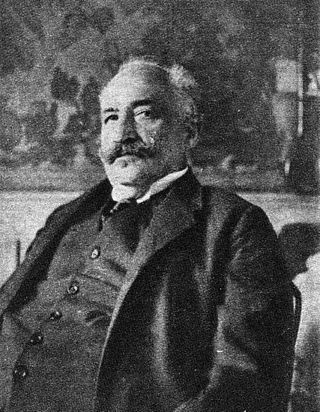
Wiener Bilder or Wiener Bilder Illustrated Sunday paper was the illustrated supplement of the Austrian conservative weekly Das interessante Blatt. [1]

Wiener Bilder or Wiener Bilder Illustrated Sunday paper was the illustrated supplement of the Austrian conservative weekly Das interessante Blatt. [1]
From 26 June 1898 to 9 July 1898, a special edition was published under the title Kaiser-Jubiläums-Schützen-Zeitungt. [2] [3] [4]

Ernst Fuchs was an Austrian painter, draftsman, printmaker, sculptor, architect, stage designer, composer, poet, and one of the founders of the Vienna School of Fantastic Realism. In 1972, he acquired the derelict Otto Wagner Villa in Hütteldorf, which he restored and transformed. The villa was inaugurated as the Ernst Fuchs Museum in 1988.

Josef Weinheber was an Austrian lyric poet, narrative writer and essayist.
Wiener Schachzeitung was the name of several Austrian chess periodicals published in Vienna between 1855 and 1949.

Arbeiterwille was social democratic paper published in Graz, Styria, Austria, from 1890 to 1934.
Max Fenichel, also known as Maximilian Fenichel and Menasche Fenichel, was an Austrian photographer.
Ferdinand Leopoldi, real name Ferdinand Israel Kohn was an Austrian pianist, hit composer and cabaret manager.

Das Interessante Blatt was an Austrian magazine which appeared weekly from 1882 to 1939. A supplement of the newspaper appeared under the title Wiener Bilder, their successor newspaper was the Wiener Illustrierte.
Richard Groner was an Austrian local historian and journalist.

Ignaz Schnitzer was a journalist, translator, librettist and newspaper founder.
Rosa CarolaStreitmann, von Jenny from 1885 and Benvenisti from 1888 was an Austrian operetta singer and singing pedagogue.

Erich Schenk was an Austrian musicologist and music historian.

Karl Haffner (pseudonym), real name Karl Schlechter, was a German dramaturge.

Wilhelm Wiesberg, real name Wilhelm Bergamenter, was an Austrian writer and folksinger.

Ludwig Karpath was an Austrian musicologist.

Der Humorist was a journal published from 1837 to 1926 with the title "eine Zeitschrift für Scherz und Ernst, Kunst, Theater, Geselligkeit und Sitte". In the years 1837 to 1848, Der Humorist was published without any further addition. Afterwards with "ein Volksblatt für alle Interessen des Rechts und des Lichts, für Leben und Kunst, für Ernst, Scherz und Satyre, nebst bildlichen, satyrischen Beilagen unter dem Titel: Karikaturen-Album".

Ludwig Speidel was a German writer, which in the second half of the 19th century was the leading music, theater and literary critic in Vienna.
Miss Europe 1927, was the first ever edition Miss Europe pageant and the only edition under Fanamet, the European distributor of Paramount. It was first held at Sofiensaal in Vienna, Austria on February 5, 1927. After the original panel of 12 judges couldn't decide the winner, a "runoff" was held on March 15, 1927 in Berlin, Germany. The winner was chosen by Friedrich Wilhelm Murnau who then starred in a movie directed by him. Štefica Vidačić of Yugoslavia emerged victorious, and was crowned Miss Europe 1927 and the first ever Miss Europe.
Willy Fränzl was an Austrian dancer.
The Neues Wiener Tagblatt was a daily newspaper published in Vienna from 1867 to 1945. It was one of the highest-circulation newspapers in Austria before 1938.
Lili Hutterstrasser-Scheidl was an Austrian composer, known by the pseudonym Lio Hans. Her opera Maria von Magdala was performed at the Vienna Volksoper on December 22, 1919, and was the only musical stage work by a female composer to be performed in Austria in the 20th century until Olga Neuwirth's Bählamms Fest in 1999.